Seasons of Magic Lantern
Magic-lantern filmstrips began to be used before World War II as a medium for education, cultural enrichment, propaganda, and entertainment. Educators were drawn to the medium because it was easy to use and the film frames could be colored directly, while using 35mm film in roll format expanded the amount of information and the dramatic content the films could convey. Use of the medium expanded rapidly after the war, when there was a boom in magic-lantern screenings at public facilities. Riding this momentum, magic-lantern films were sometimes produced with a socially critical perspective, and they became an important medium for labor unions and other social-movement organizations.
The films to be screened were selected, with the assistance of the Kobe Planet Film Archive, from the 300-plus magic-lantern films and scripts of the early 1950s that are in the archive’s collection. With skilled narration provided by the young benshi (film narrator) Kataoka Ichiro, we’re sure you’ll be able to feel keenly the atmosphere of early postwar Japan.
Co-presented by Waseda University Collaborative Research Center for Theatre and Film Arts 2011 Research Project “Empirical Studies about Alternative Practice in the History of Japanese Postwar Visual Culture: Focusing on Revaluation of Filmstrips / Slide Media and Verification of Their Cooperation with Cinema and Theater” (Research Representative : Washitani Hana)
Cooperation: Kobe Planet Film Archive
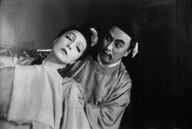 Qu Yuan, the Patriotic Poet
Qu Yuan, the Patriotic Poet
- 1952
Production: Zenshinza Theatre Company, Kinuta Yokocine Slide Company
Cast: Kawarazaki Chojuro, Tanaka Yasusuke, Imamura Izumi
Guo Moruo’s Qu Yuan (1942) was a popular anti-Japanese historical play during the Chinese movement of resistance to Japanese occupation. In September 1952, the Zenshinza staged the first performance in Japan of the play, which was filmed and edited into a magic-lantern filmstrip. The title role was one of the postwar hit performances for the actor Kawarazaki Chojuro. Another play that shared the message of resistance to colonial rule was The Secret History of Amami Oshima: The Beauty Kanteme (written by Suzuki Masao, starring Kawarazaki Kunitaro), which was staged by Zenshinza the same year and also made into a magic-lantern film.
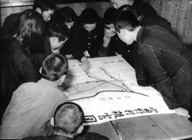 A Green Peace
A Green Peace
- 1953
Plannning, Production: The Rural Culture Association
Cast: People of Tomino Village
A film depicting a reforestation campaign conducted by junior-high school students in Tomino Village, Miyagi Prefecture. Wartime destruction of forests has left the village exposed to flooding after the war, and the students struggle to overcome the restrictions of traditional land boundary and entry rights. The film is based on real events and features the students on location in their village. The film was produced by the Rural Cultural Association, which also produced the magic-lantern version of School of Echoes. During the occupation and afterwards, the association produced many magic-lantern filmstrips aimed at providing cultural enrichment and entertainment in the rural villages of Japan.
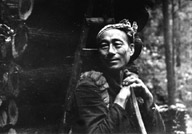 The Mountains Belong to Us
The Mountains Belong to Us
- Circa 1954
Production: Okutama Sanson Kosakutai
An educational-propaganda film produced by the mountain-villages task force of the Japanese Communist Party. The unit was dispatched by the party to the Nishi Tama district, west of Tokyo, from 1951 to 1955; it organized an effort to prevent the construction of the Ogochi Dam and to free villagers in the district from the control of feudal landowners. This is a valuable historical document that captures the cultural campaign the organizers carried out among workers in the mountain villages. Neither the film nor the script is dated, but from the production number of the film it is thought to be from 1954.
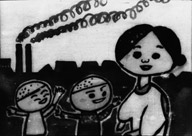 My Mother
My Mother
- 1953
Production: The University of Tokyo Settlement, Kawasaki Society for the Children
Kako Satoshi, to this day one of Japan’s leading authors of picture books and children’s literature, became involved in the Children’s Group at the University of Tokyo Settlement House in Kawasaki in 1951. He produced kamishibai (picture-story shows) and magic-lantern films to be shown to the working-class children in the neighborhood who came to the group’s gatherings. This film combines images that are suggestive of drawings done by young schoolchildren and a script rooted in daily life. It is a unique example of a group production involving children.
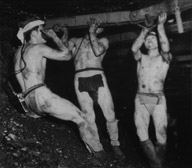 How We Fight: The 63-Day Struggle
How We Fight: The 63-Day Struggle
- 1953
Production: Japan Coal Miners’ Union
An overview of the Japan Coal Miners’ Union strike that began on October 17, 1952, with a focus on the Joban mine in Fukushima and the Kaho mine in Kyushu. It is a long film, with nearly 90 frames. ccording to a pamphlet, The Labor Union Magic-Lantern Movement (1959), published by the film’s distributor (Japan Magic-Lantern Cultural Association), this film was popular, and more than 1,000 copies were made, sparking a boom in magic-lantern productions by labor unions.
Special Events
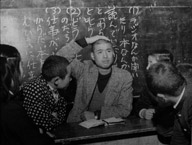 School of Echoes Magic-Lantern Screening
School of Echoes Magic-Lantern Screening
- Plannning, Production: Rural Culture Association
Cast: People of Yamamoto Village, Minami-Murayama district, Yamagata Prefecture
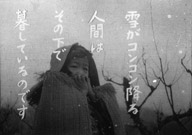 Muchaku Seikyo’s School of Echoes (1951, set in the village of Yamamoto in Yamagata Prefecture) became a bestseller and was made into a movie. This is the magic-lantern version, in which Muchaku himself appears. This film also sold very well. It will be screened with a local theater group performing the script.
Muchaku Seikyo’s School of Echoes (1951, set in the village of Yamamoto in Yamagata Prefecture) became a bestseller and was made into a movie. This is the magic-lantern version, in which Muchaku himself appears. This film also sold very well. It will be screened with a local theater group performing the script.
